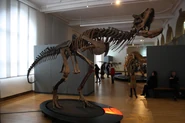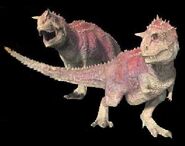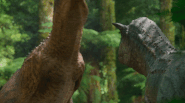| Carnotaurus Temporal range: Late Cretaceous | |
|---|---|
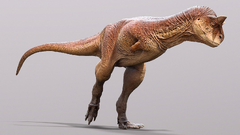
| |
| An artist's illustration of Carnotaurus sastrei, based off of a recently discovered skin fossil. | |
| Scientific classification | |
| Domain: | Eukaryota |
| Kingdom: | Animalia |
| Phylum: | Chordata |
| Superorder: | Dinosauria |
| Order: | Saurischia |
| Suborder: | Theropoda |
| Family: | †Abelisauridae |
| Tribe: | †Carnotaurini |
| Genus: | †Carnotaurus Bonaparte, 1985 |
| Species: | †C. sastrei |
| Binomial name | |
| †Carnotaurus sastrei Bonaparte, 1985 | |
Carnotaurus (meaning "meat eating bull") was an extinct genus of large abelisaurid theropod dinosaur which lived in South America during the Late Cretaceous Period. It is a relative of other theropod dinosaurs such as Abelisaurus, Majungasaurus, Ceratosaurus, and Rajasaurus. Carnotaurus lived in Patagonia, Argentina about 80 - 70 million years ago, and was discovered by José F. Bonaparte, who has discovered many other South American dinosaurs. The type and only species of this genus is C. sastrei.
Description[]
Carnotaurus was a large theropod and one of the largest abelisaurs, about 7-9 meters (23-30 ft) in length, and between 1.3-2 tonnes in weight. Abelisaurids have odd features in their heads, as Carnotaurus had two large brow horns over its eyes, while its smaller relative Majungasaurus had highly bizarre looking knob on its head. The Ceratosaurus had a few horns on its head also. It is probably the fastest running non-ornithomimid theropod, reaching a speed of up to 20 mph.
Front limbs morphology[]
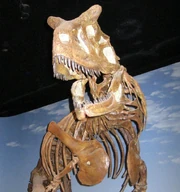
Carnotaurus sastrei skeleton
Abelisaurids also have very reduced forelimbs with four or five fingers. In particular, the arms of Carnotaurus, when compared to their body size, were proportionally far smaller than even than those of Tyrannosaurus and are possibly the smallest forelimbs in whole animal kingdom compared to body mass. The hands of this creature had four very small fingers, and only two of them actually had bones. Despite the arms small size, the shoulder joint it was attached to was very large and had a socket joint, implying these arms were used a reasonable amount for something.
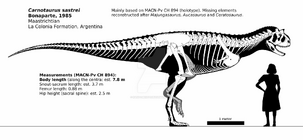
Carnotaurus skeletal reconstruction by randomdinos
Skull[]
The only known skull measures 59.6 cm (23.5 in) in length, and was proportionally shorter and deeper than what's seen in any other carnivorous dinosaur. The snout was somewhat broad, and not as tapering as seen in more basal theropods like Ceratosaurus, and the jaws were curved upwards. A prominent pair of horns formed by the frontal bones, protruded obliquely above the eyes. These horns were thick and cone-shaped, internally solid, somewhat vertically flattened in cross-section, and measured 15 cm (5.9 in) in length. Bonaparte, in 1990, suggested that these horns would probably have formed the bony cores of much longer keratinous sheaths. Mauricio Cerroni and colleagues, in 2020, agreed that the horns supported keratinous sheaths, but argued that these sheaths would not have been greatly longer than the bony cores.
In other dinosaurs, the skull was perforated by six major skull openings on each side. The frontmost of these openings, the external naris (bony nostril), was sub rectangular and directed sidewards and forwards, but was not sloping in side view as in some other ceratosaurs such as Ceratosaurus. This opening was formed by the nasal and premaxilla only, while in some related ceratosaurs the maxilla also contributed to this opening.
Carnotaurus had a very big postorbital area of skull, allowing him to bite very strong. According to paleontologist Robert Bakker, so-called "rottweiler effect" makes an animal's bite powerful. The "rottweiler effect" is especially large back part of the skull (postorbital area) where jaw muscles are located. The bigger the postorbital area - the stronger the bite force. Also, Carnotaurus's teeth are very unique design - they were very wide, and relatively blunt, resembling the railroad spike. These teeth are very suitable for crushing bone, making this carnivore's bite enormously lethal.
Possible preserved skin[]
A single nearly complete skeleton has been described, including a large skin print on the right side of the specimen, covering the head, arms, torso and legs, showing us much about its skin. It shows us that it was covered in circular non overlapping scales, with osteoderms running down the length of the back. The preserved skin on the head has either not been described yet or simply doesn't exist, with the only evidence being a photo from 2019.
Classification[]
The type species Carnotaurus sastrei is the only known species, placed in Carnotaurini Tribe along with Aucasaurus.
It is also one of the best-understood Genera of Abelisauridae. The Abelisaurids were the dominant predators in the Late Cretaceous of Gondwana, replacing the carcharodontosaurids and occupying the ecological niche filled by the tyrannosaurids in the northern continents.
Discovery[]
The only skeleton (holotype MACN-CH 894) was unearthed in 1984 by an expedition led by Argentinian paleontologist José Bonaparte. This expedition also recovered the peculiar spiny sauropod Amargasaurus. It was the eighth expedition within the project named "Jurassic and Cretaceous Terrestrial Vertebrates of South America", which started in 1976 and was sponsored by the National Geographic Society. The skeleton is well-preserved and articulated (still connected together), with only the posterior two thirds of the tail, much of the lower leg, and the hind feet being destroyed by weathering.
Age & Paleoecology[]
The Carnotaurus lived during the Late Cretaceous period, in South America. It was probably one of the more predatory dinosaurs living in its land, and may have traveled in pairs. The skull shape and the forward facing eyes of the Carnotaurus would've given it an advantage in hunting down fast prey, causing some to argue the animal was a pursuit predator while other sources argue that Carnotaurus may have even been an ambush predator.
Paleobiology[]
Horns and horn function[]
The horns were big bony bumps on the frontal bone. It's not entirely clear what the use of these horns were, several interpretations have revolved around use in fighting conspecifics or in killing prey. Though a use in display for courtship or agonistic behavior while fighting over mates.
Gerardo Mazzetta and colleagues (1998) suggested that Carnotaurus used its horns in a way similar to rams. They calculated that the neck musculature was strong enough to absorb the force of two individuals colliding with their heads frontally at a speed of 5.7 m/s each. Gregory Paul (1988) proposed that the horns were butting weapons and that the small orbita would have minimized the possibility of hurting the eyes while fighting. Fernando Novas (2009) interpreted several skeletal features as adaptations for delivering blows with the head. He suggested that the shortness of the skull might have made head movements quicker by reducing the moment of inertia, while the muscular neck would have allowed strong head blows. He also noted an enhanced rigidity and strength of the spinal column that may have evolved to withstand shocks conducted by the head and neck.
Gerardo Mazzetta and colleagues (1998) proposed that the horns might also have been used to injure/kill small prey, though horn cores are blunt, they may have had a similar form to modern bovid horns if there was a keratinous covering. However, this would be the only reported example of horns being used as hunting weapons in animals.
Function of the jaws[]
Some analyses of the Carnotaurus jaw by Mazzetta and colleagues, in 1998, 2004, and 2009, suggest that the animal was capable of quick, not strong bites. Quick bites are more important than strong bites when catching smaller prey, which was observed in studies on modern crocs. The researchers also noted a high degree of kinesis (jaw flexibility) within the skull particularly the lower jaws, slightly similar to snakes. The elasticity of the jaw would have allowed Carnotaurus to swallow small prey items whole. In addition, the dentary of the lower jaw was hinged, and thus able to move up and down. When pressed downwards, the teeth would have projected forward, allowing Carnotaurus to spike small prey items; when the teeth were curved upwards, the now backward projecting teeth would have hindered the caught prey from escaping. Mazzetta and colleagues also found that the skull was able to withstand forces that appear when tugging on large prey items. Carnotaurus may therefore have fed mainly on relatively small prey, but also was able to hunt large dinosaurs. Also in 2009, Mazzetta and colleagues estimated a bite force of around 3,341 newtons.
This interpretation was questioned by François Therrien and colleagues in 2005, who found that the biting force of Carnotaurus was twice that of the American alligator, which may have the strongest bite of any living tetrapod. These researchers also noted analogies with modern Komodo dragons: the flexural strength of the lower jaw decreases towards the tip linearly, indicating that the jaws were not suited for high precision catching of small prey but for delivering slashing wounds to weaken big prey. As a consequence, according to this study, Carnotaurus must have mainly preyed upon large animals, possibly by ambush. Cerroni and colleagues, in 2020, argued that flexibility was restricted to the lower jaw, while the thickened skull roof and the ossification of several cranial joints suggest that the skull had no or only little kinesis.
In popular culture[]
- Carnotaurus appeared in the novel The Lost World by Michael Crichton (1995) as it is somewhat of a color-changing, chameleon-like dinosaur, but this ability is purely speculative. It also appeared in a level of the video game adaptation of the film counterpart.
- Carnotaurus was set to make an appearance in the movie Jurassic Park III as the dinosaur approaching the characters as they search for a cellular phone within giant heaps of Spinosaurus dung. However this was changed to a Ceratosaurus.
- A Carnotaurus appears in the Jurassic World: Fallen Kingdom official trailer, before appearing in the film itself. These clones looked a bit different from their real-life counterparts. They were slightly oversized, had a broader snout, had pronated wrists like all of InGen’s cloned theropods, claws on all four fingers rather than just three of the four of the originals, and the speed was reduced.
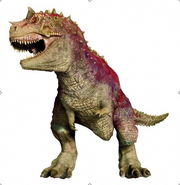
Carnotaurs from Dinosaur
- Carnotaurus was made popular by the 2000 Walt Disney movie Dinosaur, where two of the theropods (likely male and female) named Red Brute & Thick Brute (by fans) were the main antagonists as they hunted down the main protagonists while they journeyed to the Nesting Grounds. (Originally, this was supposed to have been Tyrannosaurus rex, but at the last minute they were replaced by Carnotaurus, who were also inaccurately shown to have been T. rex-sized).
At Disney's Animal Kingdom theme park, guests who ride "Dinosaur" (an attraction very loosely based on the film) are menaced by a large Audio Animatronic "Carnotaurus", among other creatures. This animatronic design differs from the model from Dinosaur, having two long crooked horns, a wider skull shape, and significant amounts of fatty tissue on the neck, along with being almost completely red. The horns also resembled horns of cattle rather than two pointed bony crests.
- In the Capcom game Dino Crisis 3, a Carnotaur pair gets brutally murdered by a savage, gigantic, black Tyrannosaurus, acting like a comeback after the T. rex's grizzly demise by a Giganotosaurus in Capcom's Dino Crisis 2.
- Carnotaurus appears in a free Jurassic World: Fallen Kingdom Update for Jurassic World: Evolution, based on the Fallen Kingdom dinosaur.
- Carnotaurus appears in Zoo Tycoon 2: Dino Danger Pack. It is also present in Zoo Tycoon 2: Extinct Animals.
- Genetic material of Carnotaurus was in InGen's possession by 2014 and was used in the creation of the genetic hybrid, Slash the Indominus rex in the film, Jurassic World.
- Carnotaurus appears in Jurassic World: Alive, based on the Fallen Kingdom dinosaur.
- It can be created from DNA in Jurassic Park III: Park Builder.
- It appears in the science fiction movie Raptor Island as the predator of the Raptors.
- Carnotaurus also appears in the 2011 series Terra Nova as a predator of humans.

Terra Nova Carnotaurus
- Carnotaurus appears in Bizarre Dinosaurs, where they talk about how strange this theropod looked.
- A Carnotaurus named Ace appeared in the anime series Dinosaur King. Ace has storm powers and is partnered with Rex Owen.
- A Carnotaurus appears in Life After Dinosaurs where it is inaccurately shown as a predator of Edmontonia (which lived in North America) and Saltasaurus.

Primal Carnage Carnotaurus
- It can be a playable dinosaur in the online game Primal Carnage.
- Carnotaurus stars in the 2013 Asylum film Age of Dinosaurs filling a similar role for the Raptors of Jurassic Park.
- Carnotaurus appears in The Land Before Time XIV: Journey of the Brave, where one is seen chasing the characters into a cave before they escape. It is seen again later in the film when the rescue party hide from it.
- Carnotaurus can be created in Jurassic Park: Builder. It is a limited edition dinosaur. It shares the Spinosaurus, Suchomimus, Yutyrannus, and Baryonyx animation. But it has large 3 fingered arms, but in reality, it had tiny 4 fingered arms.
- It can be created from DNA in Jurassic World: The Game as a rare dinosaur. It uses the same animations and sound effects of the Tyrannosaurus, Majungasaurus, Allosaurus, Megalosaurus, Metriacanthosaurus, Rajasaurus, Giganotosaurus, Yutyrannus, Gorgosaurus, and Tyrannotitan, but unlike most, it has an accurate number of fingers: 4.
- Carnotaurus was seen in Stage 7 on Dinosaur Hunting (XBOX), where two Carnotaurus became the main targets to be tranquilized and rescued.

Carnotaurus with saddle and rider in ARK: Survival Evolved
- Carnotaurus is also featured in the open-world survival game ARK: Survival Evolved, where it is the first large carnivore players can tame and ride.
- Carnotaurus is one of the interactive creatures featured in Dinosaur Adventure 3D; one features a video focusing on it while telling fun facts, and another showing it falling prey to a pack of Velociraptors.
- Carnotaurus is a playable dinosaur in the ROBLOX game "Era of Terror" it is one of the most accurately depicted animals in the game, it even has the real animal's wide turn radius. In the remake, "Era of Terror: Remastered", it is replaced by its relative Majungasaurus.
- A young Carnotaurus named Blade appears in the Chinese-Korean-American film, Dino King 2: Journey to Fire Mountain.
- A Carnotaurus named Toro appears in seasons 1 and 5 of Jurassic World: Camp Cretaceous.
- Carnotaurus made an appearance in the Roblox games called "Dinosaur Simulator" and later in 2020 "Dinosaur World Mobile", after that appearing in another Roblox game "Prior Extinction" in late 2022.
- Carnotaurus also appears in Kyouryuu Wakusei.
- Carnotaurus makes a memorable single appearance in the final episode of the first season of the documentary series Prehistoric Planet, where a male displays to a female using a possible, and quite whimsical, strategy previously hypothesized in the book All Yesterdays which released ten years earlier.
Gallery[]
References:[]
- http://animal.discovery.com/dinosaurs/carnotaurus.htm
- http://www.prehistoric-wildlife.com/species/c/carnotaurus.html
- http://www.dinochecker.com/dinosaurs/CARNOTAURUS
- https://evrimagaci.org/carnotaurus-kretase-doneminin-boynuzlu-yirticisi-9790
- https://www.nhm.ac.uk/discover/dino-directory/carnotaurus.html
- https://new.smm.org/dino-days/battle/carnotaurus
- https://www.thoughtco.com/things-to-know-carnotaurus-1093778
- https://kids.britannica.com/students/article/Carnotaurus/310585
- https://scienceviews.com/dinosaurs/carnotaurus.html
- https://www.sciencedirect.com/science/article/abs/pii/S0195667121002421 [Scaly Skin]
- https://www.smithsonianmag.com/science-nature/why-did-carnotaurus-have-such-wimpy-arms-86382093/
Documentaries:[]
- Bizarre Dinosaurs
- Life After Dinosaurs
- Prehistoric Planet
Books:[]
- Dino Wars; by Jinny Johnson, consulted by Michael J. Benton
- The Audubon Society Pocket Guides Familiar Dinosaurs; by Alfred A. Knopf.





